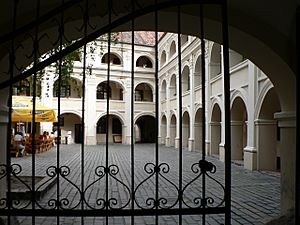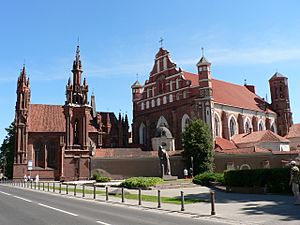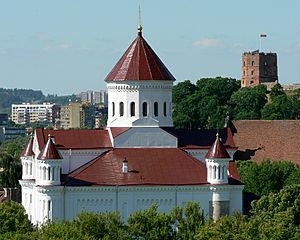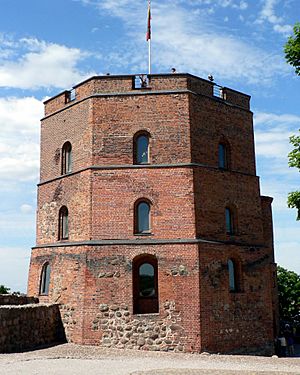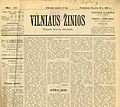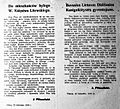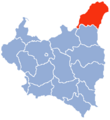History of Vilnius facts for kids
Vilnius is the capital city of Lithuania. It's a place with a long and interesting history, full of legends, important events, and changes.
Contents
How Vilnius Began: Early History
| "Legend has it that the Grand Duke of Lithuania, Gediminas, was hunting in the sacred forest near the Valley of Šventaragis. Tired after the successful day's hunt, the Grand Duke settled in nearby for the night. He fell soundly asleep and began to dream. A huge Iron Wolf was standing on top a hill and the sound of hundreds of other wolves inside it filled all of the surrounding fields and woods. Upon awakening, the Duke asked the pagan priest Lizdeika to interpret the meaning of the dream. And the priest told him: "What is destined for the ruler and the State of Lithuania, is thus: the Iron Wolf represents a castle and a city which will be established by you on this site. This city will be the capital of the Lithuanian lands and the dwelling of their rulers, and the glory of their deeds shall echo throughout the world" |
| The Legend of the Founding of Vilnius |
The story of Vilnius often starts with a famous legend. It says that Gediminas, a powerful leader of Lithuania, had a dream about a giant Iron Wolf. A priest explained that this dream meant Gediminas should build a great city and castle on that spot. This city would become the capital of Lithuania and be famous worldwide.
Historians believe Vilnius might be linked to Voruta, an old capital of Mindaugas. He was crowned as the King of Lithuania in 1253. Vilnius was first officially mentioned in letters written by Grand Duke Gediminas in 1323. He sent these letters to German cities, inviting people, including members of the Jewish community, to come and live in his new capital. In 1387, the city was given special "city rights" by Jogaila, another important Lithuanian leader.
Growing Strong: The Polish-Lithuanian Commonwealth Era
Between 1503 and 1522, strong walls were built around Vilnius to protect it. The city had nine city gates and three towers. Vilnius became very important when Sigismund August, a king, moved his court there in 1544.
A big step for the city was the founding of Vilnius University in 1579 by King Stephen Bathory. This university quickly became a leading place for science and culture in the region. It was one of the most important centers in the whole Polish-Lithuanian Commonwealth. People from many different places came to live in Vilnius, bringing their skills and ideas. This helped crafts, trade, and science to grow.
However, the city also faced tough times. During the Russo-Polish War (1654–1667), Russian forces took over Vilnius for several years. The city was badly damaged, and many people suffered. It took a long time for Vilnius to recover. But it did, and by the early 1800s, its population reached 20,000, making it one of the biggest cities in Northern Europe.
Under Russian Rule: The Russian Empire Period
In 1795, after a big change in the region's borders, Vilnius became part of the Russian Empire. It was made the capital of a new area called the Vilna Governorate. During this time, most of the city walls were taken down. By 1805, only the famous Dawn Gate was left standing.
In 1812, the city was briefly taken by Napoleon during his journey towards Moscow. Later, after an uprising in 1831, Vilnius University was closed. This was part of Russian efforts to control the region. In 1863, there was another uprising, and heavy fighting happened in Vilnius. After this, many freedoms were taken away, and using the Polish and Lithuanian languages was even banned. At the start of the 20th century, most people in Vilnius spoke Polish, Yiddish, or Russian, with fewer people speaking Lithuanian.
Changing Hands: Vilnius in the 20th Century
During World War I, from 1915 to 1918, German forces occupied Vilnius. After they left, Lithuania declared its independence on February 16, 1918. However, Vilnius became a city that changed hands many times. Different groups, including Lithuanian, Polish, and Soviet forces, fought for control.
In 1920, the Red Army gave the city back to Lithuania. But soon after, in October 1920, the Polish Army, led by General Lucjan Żeligowski, took control of Vilnius. They created a separate state called Central Lithuania. In 1922, this area became part of Poland, and Vilnius (known as Wilno in Polish) became the capital of a Polish region. During this time, Polish and Yiddish were the main languages spoken in the city.
Images for kids
-
Ethnographic composition in 1912 and territorial changes of borders of Poland after World War I
-
Piłsudski's bilingual "Proclamation to the Inhabitants of the Former Grand Duchy of Lithuania" in Lithuanian and Polish (22 April 1919).
-
View of the Vilnius Old Town, 1944


